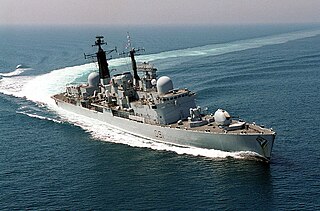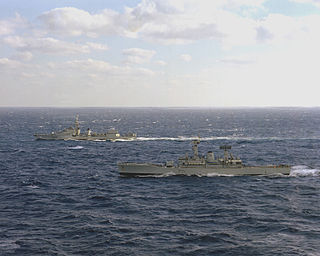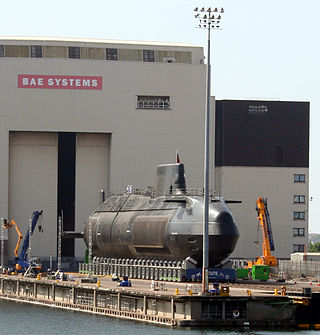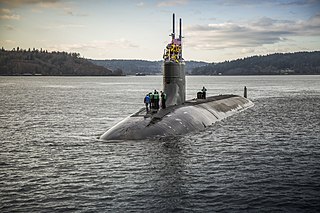
The Swiftsure class was a class of nuclear-powered fleet submarines in service with the Royal Navy from the early 1970s until 2010.

HMS Astute is an operational nuclear-powered attack submarine in the Royal Navy, the lead boat of her class.

USS Memphis (SSN-691), a Los Angeles-class submarine, was the sixth ship of the United States Navy to be named for Memphis, Tennessee. The contract to build her was awarded to Newport News Shipbuilding and Dry Dock Company in Newport News, Virginia on 4 February 1971 and her keel was laid down on 23 June 1973. She was launched on 3 April 1976 sponsored by Mrs. Cathy Beard, wife of Congressman Robin L. Beard, Jr., and commissioned on 17 December 1977, with Commander G. Dennis Hicks in command.

HMS Nottingham was a batch two Type 42 destroyer of the Royal Navy, named after the city of Nottingham, England. She was launched on 18 February 1980, and commissioned on 8 April 1983 as the sixth warship to bear the name.

HMS Triumph is a Trafalgar-class nuclear submarine of the Royal Navy and was the seventh and final boat of her class. She is the nineteenth nuclear-powered hunter-killer submarine built for the Royal Navy. Triumph is the tenth vessel, and the second submarine to bear the name. The first HMS Triumph was a 68-gun galleon built in 1561. As of 2022, she is the last boat of her class remaining in service.

HMS Trafalgar is a decommissioned Trafalgar-class submarine of the Royal Navy. Unlike the rest of the Trafalgar-class boats that followed, she was not launched with a pump-jet propulsion system, but with a conventional 7-bladed propeller. Trafalgar was the fifth vessel of the Royal Navy to bear the name, after the 1805 Battle of Trafalgar.

HMS Tireless was the third Trafalgar-class nuclear submarine of the Royal Navy. Tireless is the second submarine of the Royal Navy to bear this name. Launched in March 1984, Tireless was sponsored by Sue Squires, wife of Admiral 'Tubby' Squires, and commissioned in October 1985.

HMS Trenchant was a Trafalgar-class nuclear-powered fleet submarine of the Royal Navy built by Vickers Shipbuilding, Barrow-in-Furness. Trenchant was based at HMNB Devonport. She was the third vessel and the second submarine of the Royal Navy to be named for the characteristic of vigour and incisiveness.

USS Grayling (SSN-646), a Sturgeon-class attack submarine, was the fifth ship of the United States Navy to be named for the grayling. Her keel was laid down in 1964, and she was launched just over three years later, and commissioned in 1969. She was involved in the submarine incident off Kola Peninsula on 20 March 1993, when she collided with the Russian Navy submarine Novomoskovsk. She was decommissioned in 1997, and disposed of a year later.

HMS Scylla (F71) was a Leander-class frigate of the Royal Navy (RN). She was built at Devonport Royal Dockyard, the last RN frigate to be built there as of 2016. Scylla was commissioned in 1970, taken out of service in 1993 in accordance with Options for Change, and sunk as an artificial reef in 2004 off Whitsand Bay, Cornwall.

A nuclear submarine is a submarine powered by a nuclear reactor, but not necessarily nuclear-armed. Nuclear submarines have considerable performance advantages over "conventional" submarines. Nuclear propulsion, being completely independent of air, frees the submarine from the need to surface frequently, as is necessary for conventional submarines. The large amount of power generated by a nuclear reactor allows nuclear submarines to operate at high speed for long periods, and the long interval between refuelings grants a range virtually unlimited, making the only limits on voyage times being imposed by such factors as the need to restock food or other consumables.
The fifth HMS Sceptre is a Swiftsure-class submarine built by Vickers in Barrow-in-Furness. She was launched in 1976, with a bottle of cider against her hull. She was commissioned on 14 February 1978, by Lady Audrey White. She was the tenth nuclear fleet submarine to enter service with the Royal Navy. She was decommissioned on 10 December 2010, at which time she was the oldest commissioned vessel in the Royal Navy still available for service; in total around 1,500 men served aboard during her commission. In theory, she is replaced by the first Astute-class submarine in service, HMS Astute.

USS San Francisco (SSN-711) is a Los Angeles-class nuclear submarine, the third ship or boat of the United States Navy to be named for San Francisco, California.

The eleventh HMS Vanguard of the Royal Navy is the lead boat of her class of Trident ballistic missile-armed submarines. The submarine is based at Faslane, HMNB Clyde, Argyll, Scotland.

USS Connecticut (SSN-22) is a Seawolf-class nuclear powered fast attack submarine operated by the United States Navy. Connecticut is the fifth active United States Ship to be named for the U.S. state of Connecticut, going back to 1776. The contract to build her was awarded to the Electric Boat Division of General Dynamics Corporation in Groton, Connecticut, on 3 May 1991 and her keel was laid down on 14 September 1992. She was launched on 1 September 1997, sponsored by Patricia L. Rowland, wife of the Governor of Connecticut, John G. Rowland, and commissioned on 11 December 1998.

USS Newport News (SSN-750), a Los Angeles-class submarine, is the third ship of the United States Navy to be named for Newport News, Virginia. The contract to build her was awarded to Newport News Shipbuilding and Dry Dock Company in Newport News, Virginia on 19 April 1982 and her keel was laid down on 3 March 1984. She was launched on 15 March 1986 sponsored by Mrs. Rosemary D. Trible, and commissioned on 3 June 1989. Mayor Jessie M. Rattley presented the ship with a commemorative plaque containing the poem "Newport News," written by Newport News native Ronald W. Bell, whose poem "Admiral Rickover" also appears upon a plaque aboard the Los Angeles-class submarine Hyman G. Rickover.

HMS Daring was the nameship of the Daring-class destroyers authorised in 1944. Between 1953 and 1957 they were reclassified as "Darings" and not included in the destroyer total, but from October 1957 they reverted to classification as destroyers. Daring was built by Swan, Hunter and Wigham Richardson on the Tyne and engined by the Wallsend Slipway & Engineering Company. She was laid down on 29 September 1945; launched on 10 August 1949; and completed on 8 March 1952. She served five commissions, was placed in reserve in December 1968 and sold for scrap in 1971. She was the sixth ship of her name in the Royal Navy.

HMS Blankney was a Hunt-class destroyer of the Royal Navy and was the first and so far only warship to bear the name. She was laid down on 17 May 1940 at John Brown & Company, Clydebank, Scotland, launched on 19 December 1940 and commissioned on 11 April 1941.

The submarine Incident off Kola Peninsula was a collision between the US Navy nuclear attack submarine USS Grayling and the Russian Navy nuclear ballistic missile submarine K-407 Novomoskovsk some 150 km (90 mi) north of the Russian naval base of Severomorsk, on 20 March 1993. The incident took place when the American submarine, who was trailing her Russian counterpart, lost track of Novomoskovsk. At the time that Grayling reacquired the other submarine, the short distance of only half-mile made the collision unavoidable. The incident happened just a week before the first summit between American president Bill Clinton and the president of the Russian Federation, Boris Yeltsin.



















